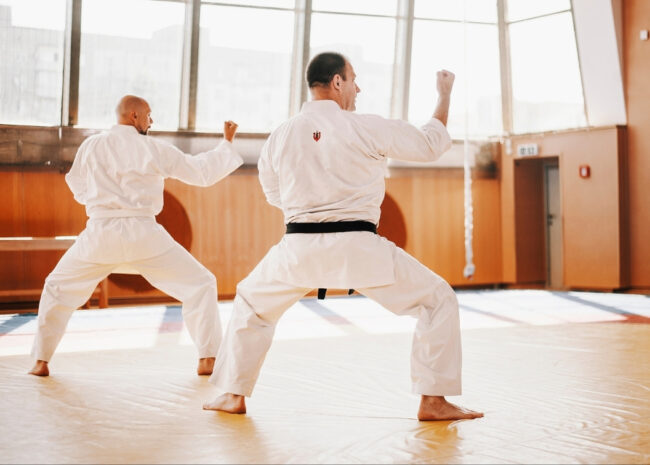
3 Ways Physical Therapy Can Boost Martial Arts Performance
Martial arts students — from kids in their first belt class to adults refining their black belt forms — push their bodies in unique ways. Kicks, takedowns, rolls, and explosive strikes all require coordination, strength, and flexibility.
But here’s something many martial artists (and their parents) don’t realize:
Physical therapy isn’t just for injury recovery. It’s a powerful tool for improving performance, too.
Top 3 Ways Physical Therapy Can Boost Your Performance:
- Improve balance and body control
- Kick higher and strike faster
- Build smart, martial arts-specific strength
At The Jackson Clinics in Centreville, our very own Dr. Chris Adams, PT, DPT, OCS, combines years of clinical experience with his own martial arts background to help students move better, train smarter, and stay injury-free.
Whether you or your child are training for fun, fitness, competition, or personal growth, here’s how working with a PT who understands martial arts can take your practice to the next level.
Why See a Physical Therapist if You’re Not Injured?
Martial artists often wait until they’re hurt to see a physical therapist. But that means missing out on the opportunity to prevent injuries and improve performance before problems start.
Here’s what’s often going on behind the scenes:
- Tight hips can reduce kicking height and make stances harder to hold
- Limited shoulder mobility can throw off balance during strikes or forms
- Core weakness can lead to poor control during rolls or takedowns
- Small muscle imbalances can increase the risk of sprains or strains over time
These issues don’t always show up as pain — but they can show up as plateaus in progress, nagging fatigue, or difficulty learning new techniques.
Working proactively with a PT trained in martial arts helps you or your child stay strong, flexible, and ready to move well.
Performance Benefit #1: Improve Balance and Body Control
– Why Balance Matters
In martial arts, balance isn’t just about standing on one foot — it’s about control during movement.
Kicks, pivots, and throws all demand precise coordination between the lower body, core, and upper body.
– The PT Advantage
Physical therapists who specialize in martial arts know how to assess movement patterns and balance to spot compensations that most people don’t even notice.
From there, the PT can develop targeted drills and strength work to help students:
- Stabilize during one-legged stances
- Improve footwork during transitions
- Build confidence in sparring or self-defense situations
Even small improvements in balance can lead to quicker reactions and cleaner technique — especially for kids who are still developing body awareness.
Performance Benefit #2: Kick Higher and Strike Faster
– Unlocking Range of Motion
Every martial artist wants to kick higher, strike faster, or move more fluidly. But that’s tough when tight hips, stiff shoulders, or limited spinal mobility are getting in the way.
– How PT Helps
Physical therapists use targeted mobility work to gently increase range of motion without overloading the joints. That means safer stretching and more functional flexibility — not just bending for the sake of it.
By identifying which muscles are limiting movement (and which might be overcompensating), you can:
- Extend your reach in strikes
- Improve posture during kata or forms
- Move with more grace and speed in competition or training
Performance Benefit #3: Build Smart, Martial Arts-Specific Strength
– Strength That Supports Technique
Not all strength training is created equal. Martial artists need power — but also control, endurance, and injury resilience.
For example:
- A strong core helps with takedown defense and explosive movements
- Stable shoulders improve striking accuracy and reduce overuse pain
- Leg strength improves kicking power and reduces knee strain
– Customized, Functional Training
At The Jackson Clinics, we tailor strength plans to the unique needs of each patient.
We take into account:
- Their style (e.g., Taekwondo vs. Jiu-Jitsu)
- Their age and training experience
- Any current limitations or goals
This type of programming is especially helpful for growing kids and teens, who may be more prone to overuse injuries if they train often without balancing strength and mobility.
Bonus Benefit: Build Body Awareness and Confidence
Physical therapy isn’t just physical. One of the greatest gifts it offers martial artists — especially younger ones — is a deeper sense of how their bodies move.
With expert guidance, students learn to:
- Listen to early signs of overtraining
- Move more efficiently during drills and sparring
- Stay focused and engaged during class
This kind of body awareness boosts confidence and safety, both in the dojo and outside it.
Is PT Right for Your Family?
You don’t need to be injured to benefit from physical therapy — especially when the provider understands martial arts from the inside out.
At The Jackson Clinics Centreville, Dr. Chris Adams has worked with martial artists of all ages and levels.
Whether your child is brand new to class or you’re looking to break through a plateau yourself, Chris can help you or your family member:
- Stay healthy and consistent with training
- Learn smart recovery and cross-training strategies
- Perform at a higher level — with fewer setbacks
Ready to Move Better and Train Smarter?
If you’ve noticed stiffness, imbalances, or performance plateaus — or if you simply want to train with more confidence — now is a great time to connect with a PT who understands martial arts.
Call our Centreville clinic at 703-830-6360 to get started today.
The Jackson Clinics serves 18 locations throughout Northern Virginia.
Find one near you: thejacksonclinics.com/locations










